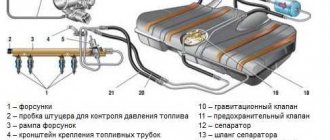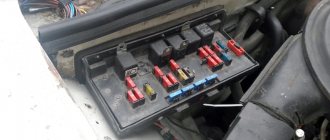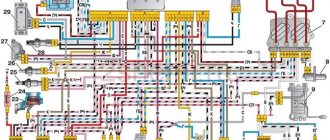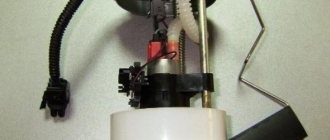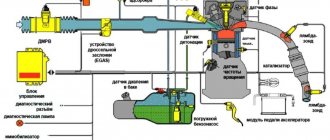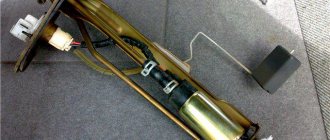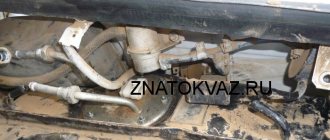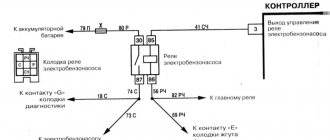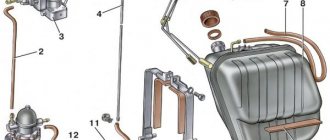On VAZ-2115 cars produced in 2000 and later, injection engines are installed, which means that the gas pump located in the fuel tank will be electric. The operation of such a fuel pump is checked every time before starting the engine. Moreover, the driver must do it correctly. When you turn on the ignition, you should hear the sound of the fuel pump turning on for a few seconds. You must wait until this noise stops and only then start the engine. This is done so that the power system has time to pass the test for its serviceability.
If, when turning on the ignition, the driver does not hear the noise of the fuel pump, then you can try to remove the negative terminal from the battery for a few minutes, this is done to reset errors in the control unit, and then turn on the ignition again. If these actions did not help get the fuel pump working, then you will have to remove the cover located on the console at the feet of the front passenger and check the condition of the 15-amp fuse, and at the same time the relay. They are located at the very bottom, of the three relays and fuses that are there.
After making sure that the fuse is intact and the relay is working properly, then you should check whether voltage is supplied to the fuel pump terminals. This can be done using a test lamp by connecting it to the plus (pink wire) and minus (black wire) terminals of the fuel pump connector. There are three terminals in this block; in addition to plus and minus, there is also a terminal (gray wire) for the fuel level indicator.
If, after turning on the ignition, the warning lamp lights up, then voltage is supplied to the terminals of the fuel pump, and the fault will have to be looked for in the pump itself. But, you need to take into account that if the voltage at the terminals is below 12 volts, the fuel pump will not work. Therefore, it is better to check the presence of voltage using a tester. You should also know that some VAZ-2115 cars are equipped with fuel pumps that have four wires in the block, as a result of which the fuel pump control circuit is different.
Owners of cars from the Samara VAZ 2114/2115 family have nothing to complain about: their cars can handle the loads quite well and rarely fail. But in some cases, the problem becomes a breakdown of the fuel pump. This is the most important element of the system, the failure of which can lead to serious problems: the motor simply will not work.
The gas pump (or fuel pump) pumps fuel from the gas tank to the engine. On models 14 and 15 of the VAZ family, the fuel pump is located in the fuel tank. The gas tank is located on the bottom of the car, in the rear. Therefore, in order to get to the fuel pump if necessary, you will need to remove the cushion from the rear seat in the cabin and find a small hatch hidden underneath.
The device is “hidden” under the rear seats, under an inconspicuous hatch in the car body
On cars of the Samara VAZ family (that is, on “fourteeners” and “tags”), “native” factory fuel pumps of the “Saratov” brand are installed. Their performance is average, but in terms of tightness they can let the driver down at any time.
However, their main advantage is their low cost.
Each owner of a VAZ-2114/2115 can easily replace an unwanted fuel pump with a better one. For example, the domestic “DAAZ” or the time-tested “Pekar”.
The production of gasoline pumps is located in Dmitrovgrad
Foreign analogues: QH (England) and OTA (Italy) also fit perfectly into the fuel system of domestic cars, however, their cost is almost three times higher than the price for a Saratov fuel pump. However, unlike domestically produced pumps, QH and OTA products are equipped with only one membrane, but a very thick one. Therefore, when using foreign expensive gasoline pumps, the possibility of fuel getting into the oil is practically excluded.
Pekarov production was opened in St. Petersburg
Table: comparative characteristics of fuel pumps for VAZ 2114/2115
| Fuel pump test results | |||||
| Characteristic | "Baker" | DAAZ | Saratovsky | QH | OTA |
| Zero supply pressure (at a crankshaft speed of 2000 rpm), kgf/cm2 | 0,26 | 0,28 | 0,26 | 0,3 | 0,36 |
| Capacity for free drainage (at a crankshaft speed of 2000 rpm), l/h | 80 | 76 | 73 | 92 | 74 |
| Suction period at crankshaft speed 200 rpm, s | 4 | 13 | 12 | 9 | 6 |
| Valve tightness at a pressure of 0.3 kgf/cm2 (fuel leakage within 10 minutes), cm3 | 8 | 12 | 20 | 8 | 8 |
| Place | 3 | 4 | 5 | 1–2 | 1–2 |
The fuel pump does not work, the relay turns on.
Checking relay power.
In the case when the fuel pump relay turns on when the ignition is turned on, but the pump itself does not work, you need to check the power at terminal 87 of the fuel pump relay. To do this, touch terminal 87 of the relay socket with the output of the control lamp connected to the vehicle ground, and the lamp should light up. If the lamp does not light, it means the fuse has blown or there is a break in the wire.
If there is power at terminal 87, you should remove the relay from the socket, and instead place a jumper between pins 87 and 30. In this case, if the pump and connecting wires are working properly, the pump should start working and if this happens, the relay should be changed. If the pump does not start working, then, without removing the jumper, you need to touch the power wire on the fuel pump with a test lamp connected to the vehicle ground.
Checking the fuel pump power circuit.
If a submersible pump is installed on the car as part of the fuel module, you need to remove the connecting connector and touch one of the thick wires. When you touch one of them, the indicator lamp should light up. If the lamp does not light up on any of the wires, then it is necessary to eliminate the break in the wire from the fuel pump relay to the module connector or the pump itself, if the pump is of a remote type. One of the reasons for the break may be the anti-theft blocking of an installed non-standard alarm system.
In the case when the test lamp lights up on one of the thick wires of the connector or one of the terminals of the remote pump, you need to connect these terminals with a test lamp to each other. In this case, the control lamp should light up. If the lamp does not light, it is necessary to eliminate a break or poor contact in the wire connecting the pump to the vehicle ground.
If, when checking the wires and relay for turning on the fuel pump, no malfunction is detected, the electric motor of the fuel pump or its connection to the module connector is faulty. It is not difficult to find the cause by removing the fuel pump module from the tank. If there is poor contact with the connector, melting of the plugs will be visible. If melting is not noticed, then to check the pump itself, you can connect it to the battery. It should be taken into account that operating a submersible pump without liquid will damage the pump. A faulty pump should be replaced.
Buying a fourteenth fret is a young thing that does not require a large budget, both for the car itself and for spare parts. If you compare the VAZ 2114 with any foreign car of the same class, you will get a decent price difference in favor of the Lada. And even if a foreign car costs more, and servicing it is not more expensive than a Lada, then spare parts from the Russian automobile industry will be much easier to find in any of the most remote areas of our country.
Whatever you say, any car wears out and requires attention and care. So let's talk about a common problem with the fourteenth - the fuel pump does not pump.
Gasoline pump VAZ 2114
You're driving, and suddenly you stall. You start it, the engine growls, the starter turns, it starts moving and again there is a stupor. Or the ignition does not respond at all, you have to push it to start. This also includes the case when the engine responds every once in a while if you slow down for a couple of minutes and go to nitral. The battery is ok. We're sinning at the fuel pump.
Why the VAZ-2115 fuel pump does not work and what to do
Many call the heart of the car its power plant.
However, it would be most correct to consider the fuel pump as such. Its functions, which are quite easy to verify, are very similar to those performed by the heart in the human body. In this material we will talk about how to determine that it is the fuel pump on the VAZ-2115 that is not working, and we will tell you about ways to eliminate the detected problems. In reality, the failure of this unit has very characteristic signs that make it easy to distinguish it from other malfunctions that occur with the machine during its operation. Most often, the car engine suddenly stalls while driving. Moreover, if you start the power plant again, very specific sounds are heard from under the hood, but the starter spins as if nothing had happened. Repeated attempts to move also end in failure.
Also, sometimes the car stops starting the first time. This problem usually occurs if it has been in neutral for some time.
The most typical symptoms of fuel pump failure are:
- the power unit of the car does not want to start;
- too low pressure level in the fuel system;
- engine tripping;
- loud “growling” of the engine at low speeds.
However, the first can happen for other reasons:
- problems with candles;
- ECU error;
- Some sensor is faulty.
An 8-valve engine tripping is a fairly typical sign of a fuel pump failure. In this case, the car drives jerkily, because the fuel flows improperly, which leads to poor performance of the cylinders.
The loud “roar” of the engine in the vast majority of cases indicates a failure of the fuel pump. Much less often, this indicates that the filters are clogged.
Why else might the pump motor not start? Here are the most common reasons:
- fuse blown;
- relay failure;
- mass break;
- failure of the electric motor installed in the pump;
- contamination of power terminals.
Symptoms of a problem
- The first sign indicating a breakdown of the fuel pump will be a banal refusal of the engine to start. Of course, such an indicator as an unstarted car is very general. In this case, it is worth checking the spark plugs, which may become oily and not produce a spark and the ECU.
- The second point is the pressure of the fuel system. If the fuel pump is OK, it creates a pressure of 3.2 bar. The fuel rail is characterized by the following indicators:
- for a volume of 1.5 l – from 285 to 325 kPa,
- for a volume of 1.6 l - from 375 to 390 kPa.
- A very common problem is when the signal does not reach the fuel pump after ignition. When you turn the key, you usually hear a slight vibration from the fuel pump, but here it doesn’t happen. Most likely the wiring has failed. We'll have to call her and figure out what's what.
- The engine is tripping. Like reason number one, this indicator is not a benchmark. It is believed that the signs of a malfunction of the VAZ 2114 fuel pump are represented by other obvious causes of malfunctions. However, if the fuel pump is not working properly, the engine begins to jerk (which is natural, fuel combustion in the cylinders occurs incorrectly), and operate intermittently out of the blue.
- The engine may jerk even before starting or at low speeds. This reason is closer to the truth: either the fuel pump or its mesh – a low-purity filter – is not working.
The fuel module, which includes the pump itself, is expensive - from 2,000 to 3,000 rubles. The inept owners of the fourteenth buy it entirely (together with the filter, fuel level sensor, float and intake chamber) and install it to replace the deceased. In fact, the price of a VAZ 2114 fuel pump is only 700-1000 rubles, you only need to take and install it, the rest of the module almost always remains intact.
Just don’t immediately run to the spare parts store and buy a new one! There are plenty of reasons for the breakdown, including those that may lie in the power system. Here are the main ones:
- Fuel pump fuse VAZ 2114
- Fuel pump relay VAZ 2114
- Poorly secured mass of the VAZ 2114 fuel pump
- Fuel pump motor VAZ 2114
- Contacts of the fuel pump system VAZ 2114
- The fuel pump itself
All these spare parts can break and stop the normal operation of the fuel module system. In fact, the fuel pump is the part of the fuel system that passes gasoline under pressure. The mechanism is complicated, we will understand it step by step.
Why the VAZ-2115 fuel pump does not work and what to do
Many call the heart of the car its power plant. However, it would be most correct to consider the fuel pump as such. Its functions, which are quite easy to verify, are very similar to those performed by the heart in the human body.
In this material we will talk about how to determine that it is the fuel pump on the VAZ-2115 that is not working, and we will tell you about ways to eliminate the detected problems. In reality, the failure of this unit has very characteristic signs that make it easy to distinguish it from other malfunctions that occur with the machine during its operation.
Most often, the car engine suddenly stalls while driving. Moreover, if you start the power plant again, very specific sounds are heard from under the hood, but the starter spins as if nothing had happened. Repeated attempts to move also end in failure.
Also, sometimes the car stops starting the first time. This problem usually occurs if it has been in neutral for some time.
The most typical symptoms of fuel pump failure are:
- the power unit of the car does not want to start;
- too low pressure level in the fuel system;
- engine tripping;
- loud “growling” of the engine at low speeds.
However, the first can happen for other reasons:
- problems with candles;
- ECU error;
- Some sensor is faulty.
An 8-valve engine tripping is a fairly typical sign of a fuel pump failure. In this case, the car drives jerkily, because the fuel flows improperly, which leads to poor performance of the cylinders.
The loud “roar” of the engine in the vast majority of cases indicates a failure of the fuel pump. Much less often, this indicates that the filters are clogged.
Why else might the pump motor not start? Here are the most common reasons:
- fuse blown;
- relay failure;
- mass break;
- failure of the electric motor installed in the pump;
- contamination of power terminals.
Pressure system
The gasoline pump creates pressure in the fuel rail for normal gasoline supply functionality. Let's measure the pressure and we'll understand a lot right away.
Normal parameters of atmospheres in the system are as follows:
- Idle – 2.5
- Ignition – from 3
- Without pressure regulator tube – 3.3
- With pinched drain – 7
- We press on the gas - from 3 to 2.5.
We will measure in these five states with a pressure gauge with a small range of atmospheres (up to 7, to reduce the error to a minimum). Under the hood we found a pressure fitting (just unscrew the cap in advance), attached a pressure gauge (hose) to the fitting and off we went. The ignition is turned on, the pressure gauge is zero: the fuel pressure regulator is broken. We press on the gas, the pressure gauge goes to zero: the fuel pump itself is broken (now you can do some shopping at a spare parts store). There may still be a situation. When the pressure gauge needle lazily rises, look at the condition of the fuel filter.
By the way, if you don’t have a pressure gauge, it’s sad and sad, because it’s an expensive pleasure. Similar diagnostics in the service will cost half as much.
Wiring contacts
The wiring system goes to the fuel pump in the number of three wires: positive, negative and gasoline level indicator. The cause of a fuel pump failure may be a simple power failure in the wiring. If everything is normal with the pressure, then we check the contacts.
We take a simple 12 V light bulb and attach its wires to the positive and negative contacts on the external connector of the fuel pump, respectively. We turn the ignition: the light blinks, there is contact. Then you need to dig deeper - look at internal contacts.
An external problem with the wiring if the light does not light up: alternately connect the positive and negative contacts removed from the fuel pump connector to the ground of the fuel pump, and then to the snout. Negative contact on ground, turn on the ignition, the light blinks - the contact is not working, the light does not blink - the positive contact is not working. When the contact is on the snout and the light comes on, the wire is damaged in the area from the fuel pump to the snout.
Weight
The fuel pump mass is located under the steering wheel, not far from the handbrake handle. It is its use that most often leads to wire breakage. In this case you will need:
- remove the cover;
- clean the ground contacts;
- attach it to its original place.
There is also a relay that controls the operation of the fuel pump. It is necessary so that when the ignition is turned on, operating pressure is immediately formed in the fuel supply system. It is important not to get confused, because there are three relays, and only one of them is related to the pump.
This element cannot be repaired and is simply replaced with a working one.
Motor
Fuel pump motor VAZ 2114
We checked the pressure and wiring, everything works like clockwork, but the engine stalls. The fuel pump may not pump due to a breakdown of the motor - the main element that drives fuel. We check its functionality with the same light bulb: attach its wires to any terminal of the motor, turn the ignition. The lamp blinked - it was time to throw out the motor. And again, run to the store for a brand new motor.
The terminals may oxidize and not make contact, as a result of which the fuel pump will not pump. The motor in this case may be normal. And the terminals just need cleaning (possibly re-soldering). There is an opinion that the terminals are oxidized due to low-quality fuel (the octane number does not match the declared one).
How to check the performance of the fuel pump
Often, for those problems for which the car owner blames the fuel pump, other elements of the fuel system are to blame. To establish whether a fuel pump has failed, you will need to know the reasons why it might break.
Causes of fuel pump malfunctions
Most often, the device may fail while the vehicle is moving. The gas pump may simply refuse to pump fuel from the tank to the engine, or a leak may form, causing the device to malfunction. If the power supply is interrupted, the pump stops working completely.
The main causes of fuel pump malfunctions include the following:
- lack of tightness in the pump itself (leakage);
- damage to membrane surfaces;
- the resource of the pump motor has been used up;
- contacts have oxidized;
- wiring or relay problems;
- dirt and debris in the fuel tank, which, along with gasoline, enter the pump.
As you can see, there can be many reasons for a fuel pump to fail.
Dirt deposits on the filter mesh are a common cause of fuel pump malfunctions.
Symptoms of a problem
There are only four main signs by which you can diagnose malfunctions in the fuel pump without special tools:
- The car simply won't start. Of course, the engine may not function for a number of other reasons, however, first of all, you will need to check the functionality of the fuel pump itself.
- After the car starts, the characteristic buzzing of the fuel pump is inaudible. The whirring noise should be clearly audible in the rear of the cabin, as the fuel pump is located under the rear seats.
- Recently, interruptions in the operation of the power unit have begun to be observed: the engine does not start the first time, while driving you can hear the engine straining.
- The car starts to jerk when driving at low speed.
Fuel pump weight
The contact system is normal, but the gasoline level sensor is acting up. Let's see what happens to the mass of the fuel pump. It may be poorly secured. In this case, the fuel pump will not be able to pump anything.
The mass of the fuel pump itself is attached to it in the area of the handbrake, under the dashboard. When you pull the handbrake, you can touch the ground contacts of the fuel pump, and the connection may be lost.
It is not difficult to tighten the mass of the fuel pump, it is difficult to reach it. Namely: get the grounding contact of the ground conducting the lost connection. We remove the plastic under the handbrake and the floor covering of the car, respectively; We clean the contact and firmly attach the mass to the fuel pump.
In the same place as the fixed mass of the fuel pump, under the dashboard, its relay is located.
Ideally, when ignited, the relay creates the required pressure in the system in a couple of moments and turns off. If this does not happen, the pressure is normal, but the process does not proceed, we completely lift the front facing panel that covers the contacts of the music and air conditioner and look from the passenger side: there are three switches, the lowest one is from the fuel pump. When you turn the key, the relay makes a characteristic click and works. If there is no click, the relay or its contacts are closed.
As they say, there is no need to waste time on trifles, if the motor terminals can be reanimated, then it is better to replace the relay and its contacts. The pleasure is inexpensive, the location for replacing spare parts is very convenient.
Repair of fuel pump VAZ 2114/2115
When repairing the fuel pump, we will proceed from the fact that we have already removed the fuel pump from the tank. How to properly dismantle the device will be written below, but we will dwell in more detail on the description of the progress of the repair work:
- You will need to remove the protective cup from the module - to do this, you will have to pry the cup latches with a screwdriver, and the fuel pump will come out freely.
We unscrew the two screws from the fuel pump housing that secure the fuel level sensor, then disconnect the cable of wires coming from the sensor and put it aside.
To complete the disassembly, you need to remove the housing itself from the device - there is a cotter pin on the surface that needs to be pulled out.
You will need to carefully examine all parts of the device for cracks, tears and deformations. As a rule, most often some specific parts of the fuel pump fail, which are much easier and cheaper to replace than to buy a new device. Replacing membranes, rubber bushings or filters is not particularly difficult: use a screwdriver to pry off the old product and pull the new one in its place. The fuel pump mesh, float or fuel level sensor can also be easily mounted with a regular screwdriver.
The unit is reassembled in the reverse order.
Video: how to repair a fuel pump on a VAZ 2115 with your own hands
Fuse
Fuse 15 A
One of the final stages of checking a malfunctioning fuel pump is its fuse. Like the relay, the fuse can be seen from the inside. Or you can climb in from the outside, through the hood. Under the hood, closer to the windshield, there will be a dark box, right on the electronic control unit. You need to open it and find the topmost fuse with a current of 15 A and the English inscription fuel pump. We take it out and look at the insides: the contact is not damaged - the fuse is alive. The contact is damaged (blown) - you need to install a new fuse. As with the price of the relay issue, buying and replacing a fuse will not be a big waste of money and time.
Not every master's hands grow from the right place. For this reason. The reason that the fuel pump does not pump can be simple stupid shortcomings of simple tuning.
For example, the alarm was installed in such a way that all the contacts were mixed up, and power simply does not go to the fuel pump. Not because the alarm should not be on the car, or the wiring system is acting up, it’s just that the person who installed it didn’t have enough brains and practice. Check all connections carefully if you decide to add some style to your little one.
Or anti-theft. The button is placed in such a way that it interrupts the integrity of the fuel pump ground contact system, and almost always fails. By the way, if you have such a lotion, I don’t think it will be very effective in the absence of a signal. And if there is a signaling system, then anti-theft is not needed at all.
In any case, remember: in any situation where a VAZ breaks down, the point is not that it is a VAZ, and it was made poorly. It’s just that the Russian auto industry is a little more delicate than the foreign one, it requires a little more attention and your ingenuity.
